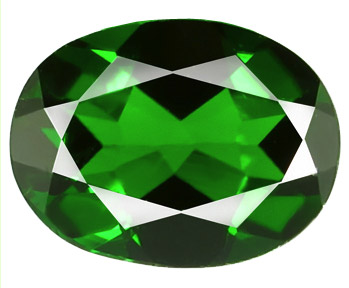Diopside
Diopside is a monoclinic pyroxene mineral that was first discovered in around 1800. It has the chemical formula MgCaSi2O6 and typically forms dull green crystals, although various other colors are known. Diopside derives its name from the Greek words, dis and opsis meaning "double" and "appearance" respectively. This name was given to Diopside because of the two possible orientations of the vertical prism. [1]

Diopside
("chrome" variety).
Diopside is found in some ultramafic igneous rocks and also in metamorphic rocks. Diopside has also been famously found in many meteorites that have fallen on Earth. In addition to these, the localities of diopside are well scattered all over the world - with 2952 localities listed in Mindat. [2]
Diopside Varieties
The most popular diopside variety with gemstone aficionados is the rich, attractive green chrome diopside. Much of this comes from the Ural Mountains in Russia. Another interesting quality of the chrome diopside is that they are sometimes found near kimberlite pipes - and so are used by prospectors as an indicator for the presence of diamonds.
Another popular variety of Diopside crystals is called Violane. Violane crystals are usually blue, purple or violet in color - due to manganese impurities. These Diopside crystals have been found in Italy and Siberia.
Tashmarine® (a brand name) is another popular type of Diopside crystals, found in the mountains of Xinjiang Province in China. The Tashmarine Diopside crystals are yellow-green to blue green. The largest Tashmarine is over 70 carats. Tashmarine was first discovered in 200, making it one of the most recent of all gemstone discoveries. [3]
A fourth variety of diopside that is of interest to gemstone collectors is star diopside. This stone is a shiny deep-green to black stone that is so dark in color that it almost appears opaque. However, due to the presence of fine rutile, the stone displays asterism - the appearance of a star in the stone when held under bright light. Star gemstones are typically cut as cabochons in order to display the asterism effect. With star diopside, the "star" is 4-rayed, whereas with several other star stones, such as star ruby and Star Sapphire, the star is 6-rayed.

Diopside
(Emerald cut. From Tanzania.
0.14 carat; 4.0 x 2.6 x 1.8mm)
Image © supplied by Freakingcat Gems
In addition to these varieties, colorless, pale green, brown, grey and white crystals of Diopside have been found in found in many countries, including Austria, Italy, Finland, Siberia, Canada, USA, Afghanistan, India and Pakistan. The largest crystal of Diopside was found in New York.
Diopside Properties
Diopside is composed of calcium magnesium silicate, containing 19 percent calcium, 11 percent magnesium and 26 percent silicon. The molecular weight of Diopside is 216 grams. Diopside displays monoclinic prismatic properties. Both simple and multiple twinning are possible.
Diopside crystals also display clean and good cleavages along with irregular and sometimes uneven fracturing. Conchoidal fracturing on some Diopside crystals has also been observed. Diopside is quite brittle with a Mohs hardness that ranges between 5.5 and 6.5. The crystals range in inclusion and hence range from transparent to opaque. Similarly the luster of the Diopside crystals also varies between vitreous and dull. [2]
Diopside has been found in association with spinel, actinolite, tremolite, grossular, andradite, fluorite, dolomite, chlorite, vesuvianite, phlogopite, olivine, iron meteorites and calcite.
The rarity of the best rich green Diopside gems makes them highly sought after in the niche gemstone market and prices may reach several hundred dollars per carat for high quality Tashmarine diopside. However many reasonable faceted diopside gemstones can be obtained for prices around $10-$50 per carat. [1]
Diopside - Sources Referenced:
[1] http://en.wikipedia.org/wiki/Diopside
[2] http://www.mindat.org/min-1294.html
[3] http://www.columbiagemhouse.com/tashmarine.html
Back to the Gemstones List home page - over 160 gemstones explored!
Please feel free to link to this page - copy / paste the text below: (click to select)
Privacy Policy | Cookie Policy | GDPR | About This Site / Terms

© gemstoneslist.com


